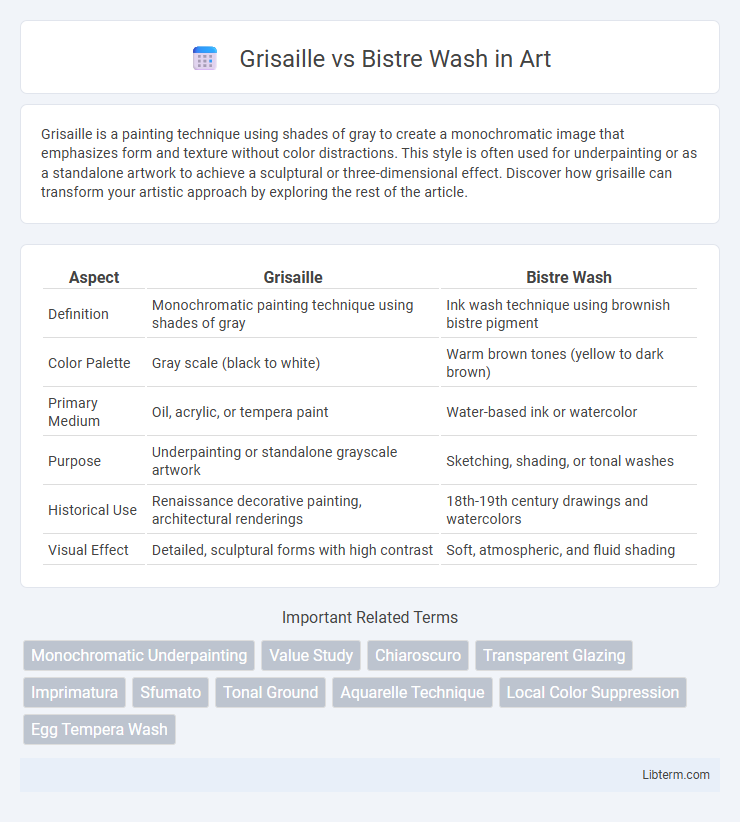Grisaille is a painting technique using shades of gray to create a monochromatic image that emphasizes form and texture without color distractions. This style is often used for underpainting or as a standalone artwork to achieve a sculptural or three-dimensional effect. Discover how grisaille can transform your artistic approach by exploring the rest of the article.
Table of Comparison
| Aspect | Grisaille | Bistre Wash |
|---|---|---|
| Definition | Monochromatic painting technique using shades of gray | Ink wash technique using brownish bistre pigment |
| Color Palette | Gray scale (black to white) | Warm brown tones (yellow to dark brown) |
| Primary Medium | Oil, acrylic, or tempera paint | Water-based ink or watercolor |
| Purpose | Underpainting or standalone grayscale artwork | Sketching, shading, or tonal washes |
| Historical Use | Renaissance decorative painting, architectural renderings | 18th-19th century drawings and watercolors |
| Visual Effect | Detailed, sculptural forms with high contrast | Soft, atmospheric, and fluid shading |
Introduction to Grisaille and Bistre Wash
Grisaille is a monochromatic painting technique using shades of gray to create depth and emphasize form, often employed in underpainting and classical art restoration. Bistre wash involves applying diluted brown ink derived from wood soot, providing warm tonal effects and a vintage aesthetic in sketches and washes. Both techniques enhance dimensionality and texture but differ in color palette and historical applications.
Historical Origins of Grisaille and Bistre Techniques
Grisaille painting originated in the Middle Ages, primarily used in illuminated manuscripts and Gothic cathedrals to mimic sculptural relief through monochromatic gray tones. The bistre wash technique dates back to the 17th century, derived from brown pigment made of soot and used extensively by artists like Rembrandt for warm tonal effects in sketches and underpaintings. Both methods showcase the evolution of tonal monochrome techniques in European art history, highlighting distinct cultural and material influences.
Key Characteristics of Grisaille Painting
Grisaille painting primarily features monochromatic gray tones, emphasizing form and volume through subtle gradations of light and shadow, often used to simulate sculpture or create underpaintings for more complex works. This technique focuses on tonal variation without color, highlighting texture and depth with a controlled value range to achieve a three-dimensional illusion. Contrastingly, Bistre wash employs warm brown hues derived from wood soot, creating a more atmospheric and textured effect than the precise, sculptural quality of Grisaille.
Unique Features of Bistre Wash Art
Bistre wash art utilizes a natural brown pigment made from soot, producing warm, earthy tones distinct from the gray monochrome of Grisaille, which relies on shades of gray to simulate sculptural effects. The unique feature of Bistre wash lies in its fluid, translucent quality that allows for dynamic layering and subtle gradations, enhancing depth and texture in drawings and paintings. This technique offers artists a versatile medium for expressive line work and atmospheric shading, often used in landscape studies and historical illustrations.
Materials and Tools Used in Both Methods
Grisaille technique employs a monochromatic palette typically created with gray or neutral pigments, often using oil or tempera paints applied with fine brushes on a smooth surface like gessoed panel or canvas. Bistre wash relies on a brownish pigment derived from wood soot, mixed with water to create a translucent ink-like wash, applied with soft brushes or quills on paper or parchment. Both methods require careful layering and control of tone, but Grisaille emphasizes opaque, solid underpainting, while Bistre wash focuses on fluid, transparent shading effects.
Differences in Application Techniques
Grisaille involves applying multiple layers of thinned gray paint to create a monochromatic underpainting that emphasizes tonal values and depth, typically using oil or acrylic mediums. Bistre wash utilizes diluted brownish ink or watercolor applied in transparent layers to achieve warm sepia tones and subtle gradations, often seen in drawings or sketches. The key difference lies in Grisaille's focus on building detailed tonal structure with opaque paint, whereas Bistre wash prioritizes fluidity and transparency for atmospheric effects.
Visual Outcomes: Grisaille vs Bistre Wash
Grisaille produces a monochromatic gray-scale effect, emphasizing form and volume through subtle tonal variations that create a sense of depth and realism. Bistre wash offers a warm, brownish tone that enhances textures with an earthy, antique feel, often evoking a sepia-like atmosphere in the artwork. The visual outcome of grisaille leans towards cold precision and sculptural qualities, while bistre wash imparts organic warmth and aged character.
Popular Artists and Notable Works
Grisaille, a monochromatic painting technique often employing shades of gray, was notably used by Jan van Eyck in "The Ghent Altarpiece" and Michelangelo in his frescoes in the Sistine Chapel. Bistre wash, characterized by its warm brown tones derived from wood soot, gained popularity in the sketches of Rembrandt and Eugene Delacroix, such as Rembrandt's "Self-Portrait with Two Circles." Both techniques remain distinguished for their ability to create depth and texture through limited color palettes, contributing to their lasting influence in art history.
Modern Uses and Adaptations
Grisaille technique, prominent in modern art restoration and digital painting, emphasizes monochromatic layering to achieve depth and tonal variation, often adapted in 3D modeling and graphic design for realistic textures. Bistre wash, favored in contemporary illustration and calligraphy, utilizes its warm brown hues to create atmospheric effects and vintage aesthetics, frequently integrated with mixed media for expressive, textured artwork. Both methods have seen renewed interest through digital tools that simulate traditional brushwork, expanding their application in animation and multimedia projects.
Choosing Between Grisaille and Bistre Wash
Choosing between Grisaille and Bistre wash depends on the desired tonal effect and historical context. Grisaille, characterized by monochromatic shades of gray, excels at creating detailed, sculptural volume and is ideal for preparatory studies or refined underpaintings. Bistre wash offers warm brown tones derived from wood soot, providing rich, aged aesthetics suited for atmospheric landscapes and vintage-style artwork.
Grisaille Infographic

 libterm.com
libterm.com